American Leaders Claim to Make This Country Student Great Again
The Existent Fashion to 'Make America Great Again'
Bruce Lesley, Campaign for Children, Get-go Focus Campaign for Children
Kid Abuse & Fail Kid Rights Children of Immigrants Early on Childhood Education Federal Upkeep Wellness Housing & Homelessness Nutrition Poverty & Family Economics
This post originally appeared on Medium. Subscribe to the Voices for Kids publication on Medium.
President Donald Trump rarely mentioned children'southward bug through much of his presidential campaign, but his inaugural speech to the nation did. However, for much of it, he painted a dark picture of a dystopian America where children are scared, poor, and uneducated.
He began by carrying over a populist theme from his campaign. Trump said, "For too long, a minor group in our nation's capital letter has reaped the rewards of regime while the people have borne the toll. Washington flourished, simply the people did not share in its wealth. Politicians prospered, but the jobs left. And the factories closed."
He has talked virtually the demand to "drain the swamp" in Washington, and yet, his Cabinet choices have been informed by lobbyists and include, as NPR's Tamara Keith describes, "a combination of millionaires, billionaires, outsiders and even a few politicians who oppose the work of the very agencies they've been tapped to lead."
That cast of characters is supposed to change Washington and aid lead a "celebrated move" that would transform an American dystopia. Said Trump:
. . .for likewise many of our citizens, a dissimilar reality exists. Mothers and children trapped in poverty in our inner cities, rusted out factories scattered like tombstones beyond the mural of our nation, an educational activity system flush with cash simply which leaves our young and beautiful students deprived of all cognition. And the crime, and the gangs, and the drugs that accept stolen too many lives and robbed our country of so much unrealized potential. This American carnage stops correct here and stops right now.
There are some pregnant issues with both Trump's assessment of "this American carnage" and, fifty-fifty worse, some of his proposed solutions. Let's start with his last indicate on criminal offense.
Get-go, Federal Bureau of Investigation (FBI) data shows that, nether any measure — whether violent criminal offense, murder and manslaughter, rape, robbery, assault, burglary, larceny, or motor vehicle theft — criminal offense rates are all down significantly between 1995 and 2014. That, as New York Times columnist Paul Krugman points out, is the "contrary of carnage."
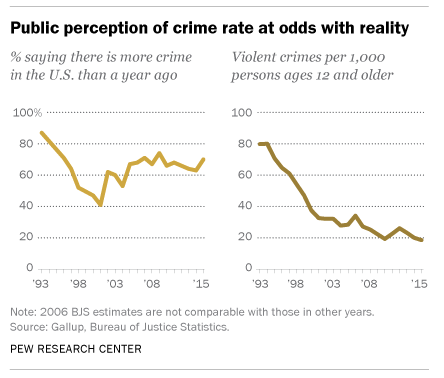
The "carnage myth" expands when you consider Trump's statement that nosotros have "an education system flush with greenbacks only which leaves our young and beautiful students deprived of all knowledge." As the Urban Found upkeep analysis shows, that simply is not true. State and local spending on education dropped by $36 billion from 2008 to 2011 or "by more than than $400 per kid betwixt 2008 and 2010," co-ordinate to Julia Isaacs, during the recession.
Furthermore, despite the subsequent economic recovery, funding for public schools has however to fully rebound. Analysis by the Center on Budget and Policy Priorities finds, "In 30 states, total state and local funding combinedfell between the 2008 and 2014 school years."
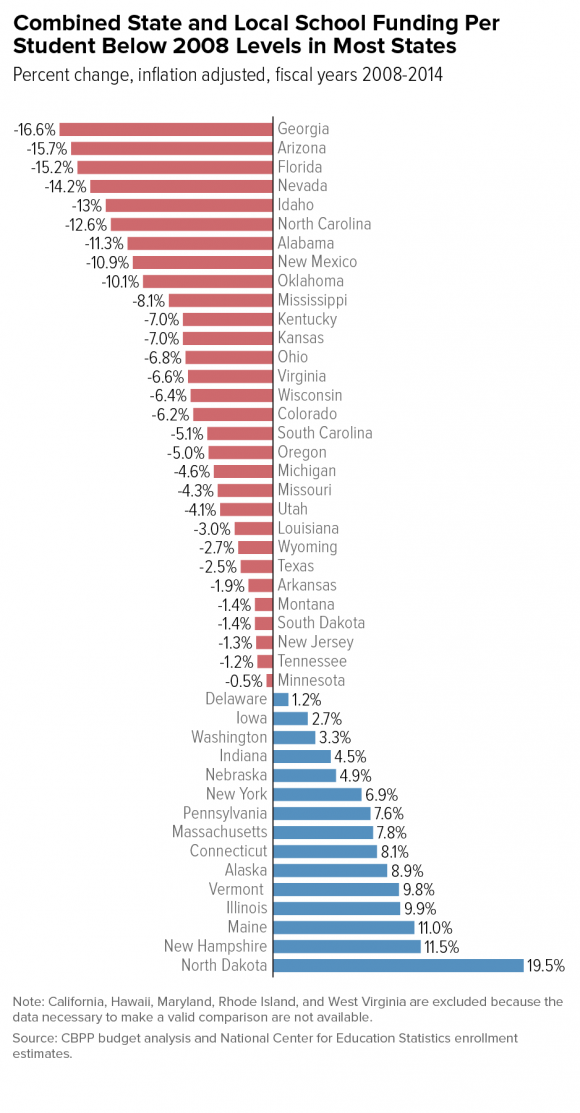
These funding problems at the country and local level are compounded by declines in federal spending on educational activity in contempo years. According to theKids' Share 2016 report, federal support for education has dropped from a high of $74 billion in 2010 to $41 billion in 2015, a reject of more than xl percent in the last v years. The Urban Plant explains, "Some decline from the ARRA (or stimulus package) years was to be expected, but it is notable that federal education spending remains nine per centum lower than in pre-recession 2008."
While there may very well be a few wealthy communities that have schools "affluent with cash," most public schools are underfunded and have a student population with growing needs. With funding cuts from all levels of government (federal, land, and local) in recent years, many school districts take had to fire teachers, increase form size, eliminate fine art, music, and extracurricular activities, and shortchange facility budgets. Equally an case,NPR reported that 1-in-five Arizona school districts have moved to iv-24-hour interval school weeks to relieve money.
In Detroit, teachers and parents had to file a joint lawsuit confronting the Land of Michigan claiming students and teachers were beingness exposed to "blackness mold, bacteria, freezing cold temperatures in classrooms, rodent and insect infestations, exposed wiring" and other hazards. Disparities between rich and poor schoolhouse districts are wide, and in some cases growing.
Co-ordinate to David Sciarra, executive director of the Education Law Center:
Public school funding in far too many states remain unfair, irrational and uncommented to the resource students must have to succeed. These states' failure to provide fair schoolhouse funding strikes hardest at the over 11 million poor, school-aged children across the United States.
In other words, poor kids and their schools are oft shortchanged of the resources they demand to be successful. A study on the impact of education funding to low-income children by Kirabo Jackson and Claudia Persico at Northwestern University and Rucker Jackson of the University of California confirms that money and equity conspicuously and unequivocally matters to low-income children. After analyzing the long-term impact to children from court-ordered school finance reforms, the authors constitute:
. . .for low-income families, a 10 percent increase in per-pupil spending each year for all 12 years of public schoolhouse is associated with 0.43 additional years of completed didactics, nine.5 percent college earnings, and a 6.viii per centum-betoken reduction in the almanac incidence of adult poverty.
Among a number of positive impacts, the authors plant that the boosted resource provided to poor schools led to "reduction in the student-to-teacher ratio, longer school years, and increased instructor salaries. . . ."
Unfortunately, one the Trump Administration'southward proposed pedagogy policies would make the funding inequity worse. According to his entrada website, Trump has proposed transferring $20 billion in federal funding, which currently provides targeted funding to public schools serving kids in poverty, to fund grants that would "favor states that accept private school pick, magnet schools and lease laws."
Trump's advisor, Kellyanne Conway, made matters worse when she argued on NBC'southward Meet the Press on Dominicus that "nosotros spent billions of dollars on education in the terminal eight years merely to have millions of kids stuck in schools that fail them every single twenty-four hour period.
Again, that statement is only not truthful. Showtime, as has already been shown, public schools receive billions of dollars less today than they did eight years ago. The fact is that policymakers at all levels of authorities have failed to invest in our children. At the federal level alone, the share of federal spending on children has dropped to only 7.8 percent.
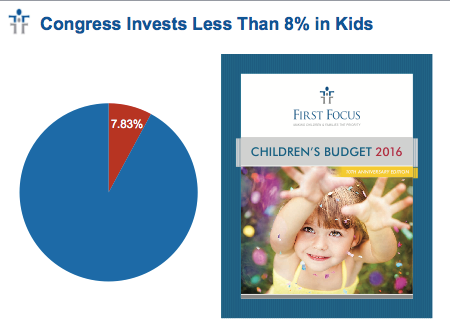
If the Trump Assistants really wants to "make America nifty over again," then it should take activeness to invest in our nation'south children rather than promoting myths or harmful policy solutions.
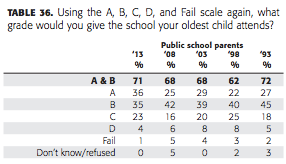
Second, I think Conway would agree that parents would be a greater authority on how their schools are performing for their children than she is, and they overwhelmingly disagree with her. According to a poll by Gallup and Phi Delta Kappa in February 2016, 71 percent of parents gave the schoolhouse their oldest kid attends either an A or B, and just one pct of parents in the survey gave their child's school a failing course of F. By definition, that means 99 percent of parents disagree with Conway'due south negative assessment of their children's public schools.
As for Trump's exclamation in his inaugural oral communication that public school students are being "deprived of all knowledge," that is simply ludicrous. The only possible explanation for that statement is that he is somehow confusing the students in public schools with Betsy DeVos, his nominee to exist Secretary of Teaching.
At her confirmation hearings, it was DeVos who showed an utter lack of basic understanding, experience, and knowledge with respect to an array of education issues.
Due to the combined lack of knowledge of or appreciation for public schools by Trump, Conway, and DeVos (if she is confirmed by the Senate), they would be wise to take a trip down to Thomas Jefferson'southward dwelling house at Montecello and the Academy of Virginia in Charlottesville, Virginia, in gild to learn about and empathize Jefferson's vision as to the importance of public education and the "diffusion of knowledge among the people" in ensuring an informed citizenry. Jefferson believed that the success of public education was cardinal to the protection of a autonomous lodge. In his words, "No other sure foundation tin can be devised for the preservation of freedom and happiness. . . ."
Rather than protection and building upon this foundation of public instruction, our nation is currently on a path of defunding our schools and failing to provide a fair system of schoolhouse finance that ensure all of our nation'south students, including our poorest children, receive adequate and equitable resources to live upwardly to their full potential. As the 2013 Equity and Excellence Committee reported to Congress:
. . .disadvantaged students enter schoolhouse far behind their more than advantaged peers. Simply instead of getting deadly serious about remedying that fact — by making sure such students are in high-quality early childhood and pre-K programs, attend schools staffed with teachers and leaders who have the skills and knowledge to assist each student attain loftier standards, get afterward-school counseling or tutorial help or the eyeglasses they need to meet the smart board — the current American system exacerbates the trouble past giving these children less of everything that makes a difference in instruction.
This link between instruction attainment, equitable school financing, and poverty is critical if nosotros wish to alive up to our nation's hope to strive to provide equal opportunity. Due to our highly inequitable organisation of financing, children currently receive wildly different and inequitable levels of funding merely because of their school district, zip code and school they attend.
Nobel Prize winner Joseph Eastward. Stiglitz points out, "Most societies recognize a moral obligation to help ensure that immature people can live upwardly to their potential" and attempt to increase the educational opportunity among its most disadvantaged children. In contrast, he writes that the U.s.a. stands out among nations in a negative mode because, "in America, more is spent on the education of rich students than on the teaching of the poor."
Nosotros should likewise not undermine our nation's public schools through school choice voucher initiatives, as have been promoted by none other than DeVos in her home State of Michigan. DeVos'south privatization movement in Michigan have harmed public schools and failed its students.
Although Trump does not seem to grasp or make the linkage between efforts to reduce poverty in order to meliorate education attainment, his speech communication did telephone call for the nation to address the "carnage" of "mothers and children trapped in poverty in our inner cities. . . ." We very much capeesh his focus on taking action to reduce child poverty, equally far too many of our nation's leaders merely ignore the outcome completely.
However, President Trump should stop singling out "our inner cities" for that focus or he will leave millions of rural and suburban children behind. In fact, although urban (27.ii percent) child poverty rates exceed that of rural (24.3 pct) and suburban (16.0 percent) kids in 2015, the Carsey Institute at the University of New Hampshire reports that rural children have higher rates of child poverty than urban kids in the 19 states of Alabama, Alaska, Arizona, Arkansas, Colorado, Florida, Georgia, Hawaii, Idaho, Kentucky, Louisiana, Montana, New Mexico, North Carolina, Oregon, Southward Carolina, Southward Dakota, Virginia, and Washington.
The fact is that child poverty is bars to neither "red" nor blue" areas of the country, as poverty impacts an astounding 30 percent of children in both the "blue" cities of the Northeast and "ruby" rural areas in the South. Moreover, the eleven states with kid poverty rates that are at 24 percent or greater were Alabama, Arizona, Arkansas, Georgia, Kentucky, Louisiana, Mississippi, New Mexico, South Carolina, Tennessee, and Due west Virginia — 10 of which voted in favor for Trump for president and are more rural, equally a grouping, than the national average.
With that in mind, we are urging the Trump Assistants to work with Congress and find bipartisan solutions to accost child poverty in the coming yr. For example, our nation's leaders could make existent progress for children by adopting a Child Poverty Target, passing a number of of import bipartisan bills, including the Family Get-go Prevention Services Deed, the Homeless Children's and Youth Human action, and the Two-Generation Economic Empowerment Act, and reauthorizing both the Children'south Health Insurance Programme (CHIP) and the Maternal Babe Early Babyhood Habitation Visiting (MIECHV) program.
Meanwhile, we must not become backwards. In Trump's inaugural speech, he said:
Every decision on trade, on taxes, on immigration, on strange affairs volition exist made to benefit American workers and American families.
Consequently, at the very least, Trump and Congress should prefer a "do no harm" standard for our nation's children and families. Among other things, they should enact no changes to our immigration policies without first protecting DREAMers from damage. They should not repeal the Affordable Care Act (ACA) without a replacement that would protect American children and families from being left worse off with respect to coverage, benefits, or affordability. And, they should refrain passing policies that would exercise considerable damage to our nation's children, such as the block granting of Medicaid.
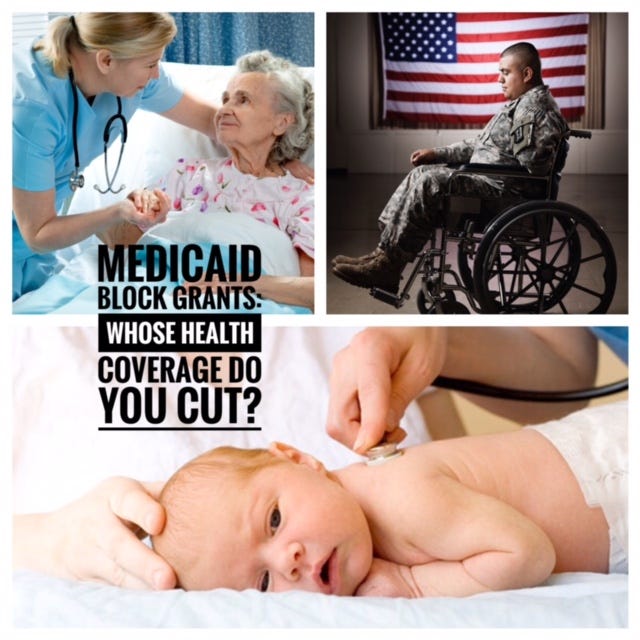
Every bit Trump said:
. . .whether a child is born in the urban sprawl of Detroit or the windswept plains of Nebraska, they look up at the aforementioned night sky, they make full their middle with the aforementioned dreams and they are infused with the breath of life by the same Almighty Creator.
In the next iv years, 16 million children will be born in America. If nosotros want to do right by them and let them to fulfill their dreams, then information technology requires that we invest in their hereafter.
That is the real way to "make America great again."
![]() Tweet: The Existent Way to 'Brand America Slap-up Over again' http://ow.ly/MLA6308ob6M #InvestInKids
Tweet: The Existent Way to 'Brand America Slap-up Over again' http://ow.ly/MLA6308ob6M #InvestInKids
Source: https://firstfocus.org/blog/the-real-way-to-make-america-great-again
0 Response to "American Leaders Claim to Make This Country Student Great Again"
Post a Comment